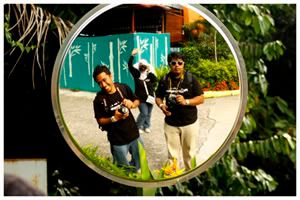1. Choosing a Portfolio Case
Choosing a case for your work should be the first step of creating your graphic design portfolio. The style of the case and the size of the case will play a role in what will be inside. You don’t need to have the most expensive portfolio in the world, but it should be nice, new and look professional. Don’t show up with your parents beat up portfolio case that’s been sitting in the attic for 10 years!
Be sure to also take into account the size of the pages to see if it will be a good size to display the work you have. For example, if you do a lot of poster designs you may want a larger case so you can print your designs at a larger size.
2. Your Portfolio’s Background Paper
The background paper in your case should be a neutral color, most likely a white or light grey and should be used throughout your entire portfolio. Try to avoid switching background colors because it can be shocking to the view and throw of the flow of your portfolio.
3. Consistency
Like your paper usage, the work and placement of your work should be consistent as well. If you center all your designs on each page make sure they are center everywhere. Try to keep spacing even around the sides as well. Showing errors in consistency your portfolio will reflect what your design work could be like.
4. Including the Right Designs
You should spend a lot of time choosing the right work for your portfolio. If you are in design school be sure to have your teachers help you out, or ask your designer friends for input. Your work should be current and you should tailor the type of work in your portfolio to the job you are applying for. If you are applying for a job at a magazine, be sure to include projects related to this area of work. Don’t show up with a bunch of CD covers and poster designs and no magazine covers or spreads.
5. Strong Start
When the viewer opens your portfolio you want to “wow” them, but the key is to keep them “wowed” throughout the entire presentation. Pick one of your strongest pieces for the opening page, which is usually a single page and not a spread. Its better to keep your resume and any other paper work in the back or in a separate folder.
6. Strong Finish
Ending strong is just as important as starting strong, if not more important, because you want to leave a good visual memory in the mind of the viewer. You should include another very strong piece at the end. Your portfolio should get stronger as it goes on, not weaker!
7. Placement of Work
Your work should be trimmed neatly with no rough edges and placed firmly on each page. You should use some sort of sticky tack or removable double sided tape so your work does not shift around on the page. The last thing you wanna do is open up a portfolio for an interview and see all your work jumbled around and falling out of the page slips!
8. Labeling Your Work
More often than not, interviewers will ask you to leave a portfolio at the office for future viewing so labeling your work with a title and very brief description can help refresh their memory if they begin looking through your portfolio again. Labels can also serve as notes for you while you talk about your work. Keep the labels consistent; in the same place, size and fonts.
9. Talking About Your Work
It is very important to be able to speak about each piece in your portfolio for at least a few minutes each. Know who it was for, what the project details were, what you did, what the concept was, what style you used, why and so on!
10. Practice Makes Perfect
You may know everything there is to know about your work, but being able to speak about it confidently is a whole other game. Practice in front of friends, family and even strangers so you can get over any uncomfortable feelings sooner than later. The more your practice the better your presentation will be! Just remember not to ramble on for too long on about each project.
11. Networking
Networking is an essential aspect of any career, and the more designers and art directors you know the better. Its great to be able to show your portfolio to honest people in the field. Most designers and art directors are used to giving honest, non bull-crap critiques so their opinions can be very valuable!
12. Maintaining and Updating your Portfolio
Keeping you portfolio current is important because you could unexpectedly get fired, or your dream job might pop up out of no where! You need to be ready at a moments notice; so update your portfolio once in a while and this includes replacing any bent or ripped pieces of work and cleaning fingerprints and smudges from the clear page slips.



 I just have fun playing this website http://www.photofunia.com/. I can change my picture in the different effects or situation that look good & funny sometime...hahaha...see all this picture that i just doing some effects on that for u as a sample...all of u can enjoy with this site...really fun!!! Hehe...Daaaaa....
I just have fun playing this website http://www.photofunia.com/. I can change my picture in the different effects or situation that look good & funny sometime...hahaha...see all this picture that i just doing some effects on that for u as a sample...all of u can enjoy with this site...really fun!!! Hehe...Daaaaa....










































